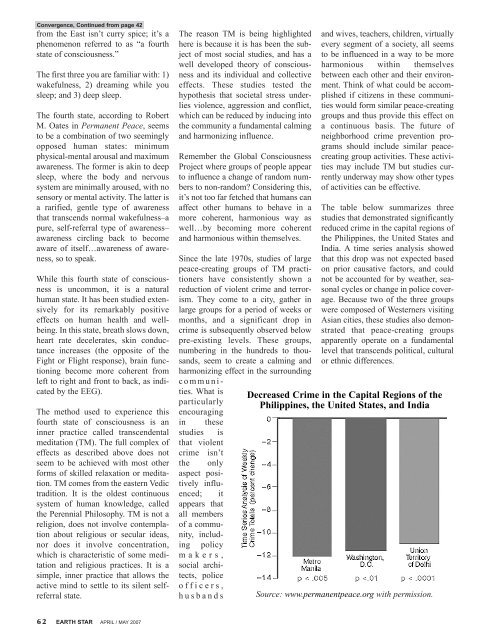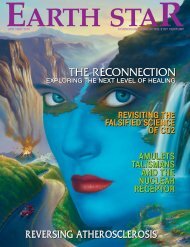You also want an ePaper? Increase the reach of your titles
YUMPU automatically turns print PDFs into web optimized ePapers that Google loves.
Convergence, Continued from page 42from the East isn’t curry spice; it’s aphenomenon referred to as “a fourthstate of consciousness.”The first three you are familiar with: 1)wakefulness, 2) dreaming while yousleep; and 3) deep sleep.The fourth state, according to RobertM. Oates in Permanent Peace, seemsto be a combination of two seeminglyopposed human states: minimumphysical-mental arousal and maximumawareness. The former is akin to deepsleep, where the body and nervoussystem are minimally aroused, with nosensory or mental activity. The latter isa rarified, gentle type of awarenessthat transcends normal wakefulness–apure, self-referral type of awareness–awareness circling back to becomeaware of itself…awareness of awareness,so to speak.While this fourth state of consciousnessis uncommon, it is a naturalhuman state. It has been studied extensivelyfor its remarkably positiveeffects on human health and wellbeing.In this state, breath slows down,heart rate decelerates, skin conductanceincreases (the opposite of theFight or Flight response), brain functioningbecome more coherent fromleft to right and front to back, as indicatedby the EEG).The method used to experience thisfourth state of consciousness is aninner practice called transcendentalmeditation (TM). The full complex ofeffects as described above does notseem to be achieved with most otherforms of skilled relaxation or meditation.TM comes from the eastern Vedictradition. It is the oldest continuoussystem of human knowledge, calledthe Perennial Philosophy. TM is not areligion, does not involve contemplationabout religious or secular ideas,nor does it involve concentration,which is characteristic of some meditationand religious practices. It is asimple, inner practice that allows theactive mind to settle to its silent selfreferralstate.The reason TM is being highlightedhere is because it is has been the subjectof most social studies, and has awell developed theory of consciousnessand its individual and collectiveeffects. These studies tested thehypothesis that societal stress underliesviolence, aggression and conflict,which can be reduced by inducing intothe community a fundamental calmingand harmonizing influence.Remember the Global ConsciousnessProject where groups of people appearto influence a change of random numbersto non-random? Considering this,it’s not too far fetched that humans canaffect other humans to behave in amore coherent, harmonious way aswell…by becoming more coherentand harmonious within themselves.Since the late 1970s, studies of largepeace-creating groups of TM practitionershave consistently shown areduction of violent crime and terrorism.They come to a city, gather inlarge groups for a period of weeks ormonths, and a significant drop incrime is subsequently observed belowpre-existing levels. These groups,numbering in the hundreds to thousands,seem to create a calming andharmonizing effect in the surroundingcommunities.What isparticularlyencouragingin thesestudies isthat violentcrime isn’tthe onlyaspect positivelyinfluenced;itappears thatall membersof a community,includingpolicymakers,social architects,policeofficers,husbandsand wives, teachers, children, virtuallyevery segment of a society, all seemsto be influenced in a way to be moreharmonious within themselvesbetween each other and their environment.Think of what could be accomplishedif citizens in these communitieswould form similar peace-creatinggroups and thus provide this effect ona continuous basis. The future ofneighborhood crime prevention programsshould include similar peacecreatinggroup activities. These activitiesmay include TM but studies currentlyunderway may show other typesof activities can be effective.The table below summarizes threestudies that demonstrated significantlyreduced crime in the capital regions ofthe Philippines, the United States andIndia. A time series analysis showedthat this drop was not expected basedon prior causative factors, and couldnot be accounted for by weather, seasonalcycles or change in police coverage.Because two of the three groupswere composed of Westerners visitingAsian cities, these studies also demonstratedthat peace-creating groupsapparently operate on a fundamentallevel that transcends political, culturalor ethnic differences.Decreased Crime in the Capital Regions of thePhilippines, the United States, and IndiaSource: www.permanentpeace.org with permission.62 EARTH STAR APRIL / MAY 2007
















